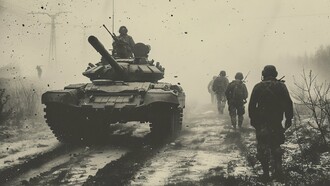Driven by the United States, which commands NATO and the European Union, militarism is threatening to spread to Europe. The U.S. military-industrial complex, together with the European one, is driving much of the military policy being developed at the global level, where the absence of political leadership by the major Western powers is becoming increasingly evident. With an American general, Christopher G. Cavoli, leading NATO; a Norwegian military spokesman, Jens Stoltenberg; and a Spanish political spokesman, Josep Borrell, they have created a situation of uncertainty which, having been initiated by Russia's invasion of Ukraine in 2022, has led to a geopolitical realignment that has given rise to an unprecedented escalation of arms. Added to this is the increasingly less hidden dispute for world hegemony between the United States and the People's Republic of China, which could eventually open a new front to those already existing in Asia, where Taiwan could be the detonator. The recovery of this territory is part of China's state policy since 1949, non-renounceable and recoverable at any price, as the Beijing government has made known.
According to figures published by the Swedish International Peace Research Institute (SIPRI) in April last year, global spending on arms reached a record in real terms in 2022, reaching 2.24 trillion dollars. This is equivalent to an increase of 3.7% globally, while Western and Central Europe reached the highest military budget spending since the end of the Cold War, increasing by 13%, equivalent to $345 billion. As usual, the top spenders were the United States, China, and Russia, which accounted for 56% of total global spending.
Of the 10 largest arms exporters, six are European, and if we go to the top 30, we find countries that have traditionally been pacifists, such as Sweden, which ranks 13th, Norway 22nd, Finland 29th, and Denmark 30th. Sweden abandoned 200 years of neutrality by joining NATO after Turkey lifted the veto, it had imposed on it in exchange for a negotiation that allowed it to buy 40 F-16 aircraft from the United States and modernize the 79 it has, for a value of 20 billion dollars. Washington quickly proceeded to lift the restrictions it was maintaining on the government of President Recep Tayyip Erdogan for the purchase it made from Moscow of an air defense system, S-400, in 2020. In 2019, India acquired the same system for $5.4 billion. Sweden, for its part, closed the sale of Gripen fighter jets to Brazil for the sum of close to $5 billion. As always, business is business.
The arms business moves politics in the world. Crises are necessary for the industry and must be permanent, so that the military arms production complexes, which mobilize science, research, technology, and capital and generate millions of jobs, are permanently supplying the markets, sometimes taking care of the forms, but always reaching agreements in the end. The late British historian Eric Hobsbawm pointed out in 2002 that in the Great War of 1914-1918, 95% of the victims were soldiers and only 5% were civilians. Things changed at the end of World War II in 1945, when the figure for civilians rose to 66%. In the wars in Afghanistan, Iraq, and Syria, civilian casualties are close to 80%. We do not yet know the outcome of the current conflicts between Russia and Ukraine or the war between Israel and Hamas, where there is already talk of a genocide of the civilian population.
Russia's aggression against Ukraine unleashed the paranoia of Moscow's imperialist territorial ambitions in Europe. Its neighboring countries, such as the Baltics, are fearful, despite being NATO members. The Nordic countries, Finland, Sweden, and Norway, also feel threatened. All NATO members have committed not only to reaching 2% of GDP in defense spending, as demanded by former President Donald Trump but will go further in 2024. For example, Poland, will reach 3.1%, the United Kingdom 3%, and Germany 2%. New NATO members Finland and Sweden will spend 2.3% and 2% respectively. It is clear that, in order to achieve this expenditure, all other budgets will be cut, as pointed out, in the German case, by Federal Chancellor Olaf Scholz, while his defense minister, Boris Pistorius, said that "as the most populous and economically strongest country in the center of Europe, Germany must be the backbone of deterrence and collective defense" on the continent.
The annual expenditure of 33 billion dollars over 10 years (equivalent to about 15% of the 2.24 trillion dollars in arms exports in 2022), would be enough to put an end to hunger in the world, according to the former director general of FAO, José Graziano da Silva. In short, the major countries seem determined to ignore historical experience and the disasters caused by wars, where the civilian population is the main victim.
Likewise, climate change and the conservation of the planet are not a real concern of the political leaders who govern us. The United Nations continues to be a body that consumes an enormous number of resources and is incapable of preventing, intervening, or stopping wars. European countries, and especially the Nordic countries that were supposed to be an ethical reserve of some kind with respect to war, have taken a stand for militarism. Sweden has not only introduced compulsory military service but has also liberalized the sale of arms to dictatorships. These are countries that have not directly experienced war for a long time and perhaps underestimate the pain of seeing their young soldiers return home in coffins draped with their national flags.















